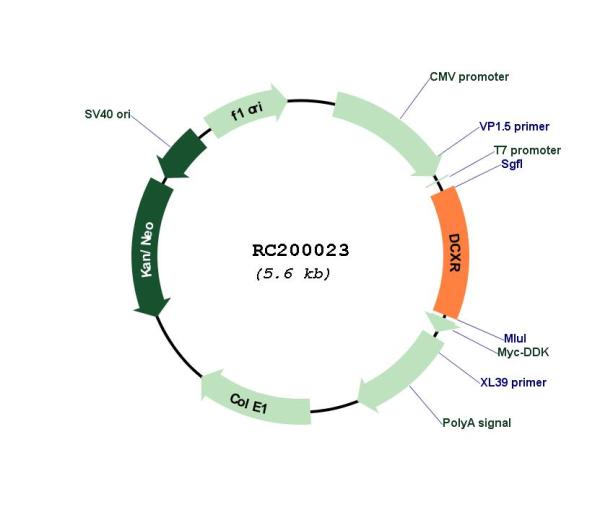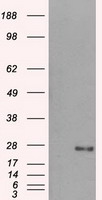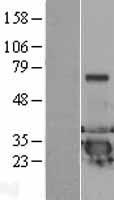DCXR (NM_016286) Human Tagged ORF Clone
CAT#: RC200023
DCXR (Myc-DDK-tagged)-Human dicarbonyl/L-xylulose reductase (DCXR), transcript variant 1
ORF Plasmid: tGFP
"NM_016286" in other vectors (6)
Need custom modification / cloning service?
Get a free quote
CNY 2,400.00
CNY 3,705.00
CNY 300.00
CNY 1,999.00
CNY 2,700.00
Specifications
| Product Data | |
| Type | Human Tagged ORF Clone |
| Tag | Myc-DDK |
| Synonyms | DCR; HCR2; HCRII; KIDCR; P34H; PNTSU; SDR20C1; XR |
| Vector | pCMV6-Entry |
| E. coli Selection | Kanamycin (25 ug/mL) |
| Mammalian Cell Selection | Neomycin |
| Sequence Data |
>RC200023 ORF sequence
Red=Cloning site Blue=ORF Green=Tags(s) TTTTGTAATACGACTCACTATAGGGCGGCCGGGAATTCGTCGACTGGATCCGGTACCGAGGAGATCTGCC GCCGCGATCGCC ATGGAGCTGTTCCTCGCGGGCCGCCGGGTGCTGGTCACCGGGGCAGGCAAAGGTATAGGGCGCGGCACGG TCCAGGCGCTGCACGCGACGGGCGCGCGGGTGGTGGCTGTGAGCCGGACTCAGGCGGATCTTGACAGCCT TGTCCGCGAGTGCCCGGGGATAGAACCCGTGTGCGTGGACCTGGGTGACTGGGAGGCCACCGAGCGGGCG CTGGGCAGCGTGGGCCCCGTGGACCTGCTGGTGAACAACGCCGCTGTCGCCCTGCTGCAGCCCTTCCTGG AGGTCACCAAGGAGGCCTTTGACAGATCCTTTGAGGTGAACCTGCGTGCGGTCATCCAGGTGTCGCAGAT TGTGGCCAGGGGCTTAATAGCCCGGGGAGTCCCAGGGGCCATCGTGAATGTCTCCAGCCAGTGCTCCCAG CGGGCAGTAACTAACCATAGCGTCTACTGCTCCACCAAGGGTGCCCTGGACATGCTGACCAAGGTGATGG CCCTAGAGCTCGGGCCCCACAAGATCCGAGTGAATGCAGTAAACCCCACAGTGGTGATGACGTCCATGGG CCAGGCCACCTGGAGTGACCCCCACAAGGCCAAGACTATGCTGAACCGAATCCCACTTGGCAAGTTTGCT GAGGTAGAGCACGTGGTGAACGCCATCCTCTTTCTGCTGAGTGACCGAAGTGGCATGACCACGGGTTCCA CTTTGCCGGTGGAAGGGGGCTTCTGGGCCTGC ACGCGTACGCGGCCGCTCGAGCAGAAACTCATCTCAGAAGAGGATCTGGCAGCAAATGATATCCTGGATT ACAAGGATGACGACGATAAGGTTTAA >RC200023 protein sequence
Red=Cloning site Green=Tags(s) MELFLAGRRVLVTGAGKGIGRGTVQALHATGARVVAVSRTQADLDSLVRECPGIEPVCVDLGDWEATERA LGSVGPVDLLVNNAAVALLQPFLEVTKEAFDRSFEVNLRAVIQVSQIVARGLIARGVPGAIVNVSSQCSQ RAVTNHSVYCSTKGALDMLTKVMALELGPHKIRVNAVNPTVVMTSMGQATWSDPHKAKTMLNRIPLGKFA EVEHVVNAILFLLSDRSGMTTGSTLPVEGGFWAC TRTRPLEQKLISEEDLAANDILDYKDDDDKV |
| Chromatograms |
CHROMATOGRAMS
 Sequencher program is needed, download here. |
| Restriction Sites |
SgfI-MluI
Cloning Scheme for this gene
Plasmid Map

|
| ACCN | NM_016286 |
| ORF Size | 732 bp |
| OTI Disclaimer | The molecular sequence of this clone aligns with the gene accession number as a point of reference only. However, individual transcript sequences of the same gene can differ through naturally occurring variations (e.g. polymorphisms), each with its own valid existence. This clone is substantially in agreement with the reference, but a complete review of all prevailing variants is recommended prior to use. More info |
| OTI Annotation | This clone was engineered to express the complete ORF with an expression tag. Expression varies depending on the nature of the gene. |
| Product Components | The ORF clone is ion-exchange column purified and shipped in a 2D barcoded Matrix tube containing 10ug of transfection-ready, dried plasmid DNA (reconstitute with 100 ul of water). |
| Reconstitution | 1. Centrifuge at 5,000xg for 5min. 2. Carefully open the tube and add 100ul of sterile water to dissolve the DNA. 3. Close the tube and incubate for 10 minutes at room temperature. 4. Briefly vortex the tube and then do a quick spin (less than 5000xg) to concentrate the liquid at the bottom. 5. Store the suspended plasmid at -20°C. The DNA is stable for at least one year from date of shipping when stored at -20°C. |
| Note | Plasmids are not sterile. For experiments where strict sterility is required, filtration with 0.22um filter is required. |
| Reference Data | |
| RefSeq | NM_016286.4 |
| RefSeq Size | 860 bp |
| RefSeq ORF | 735 bp |
| Locus ID | 51181 |
| UniProt ID | Q7Z4W1 |
| Domains | adh_short |
| Protein Families | Druggable Genome |
| Protein Pathways | Metabolic pathways, Pentose and glucuronate interconversions |
| MW | 25.9 kDa |
| Gene Summary | The protein encoded by this gene acts as a homotetramer to catalyze diacetyl reductase and L-xylulose reductase reactions. The encoded protein may play a role in the uronate cycle of glucose metabolism and in the cellular osmoregulation in the proximal renal tubules. Defects in this gene are a cause of pentosuria. Two transcript variants encoding different isoforms have been found for this gene.[provided by RefSeq, Aug 2010] |
Documents
| Product Manuals |
| FAQs |
| SDS |
Resources
Other Versions
| SKU | Description | Size | Price |
|---|---|---|---|
| RC200023L1 | Lenti ORF clone of Human dicarbonyl/L-xylulose reductase (DCXR), transcript variant 1, Myc-DDK-tagged |
CNY 4,800.00 |
|
| RC200023L2 | Lenti ORF clone of Human dicarbonyl/L-xylulose reductase (DCXR), transcript variant 1, mGFP tagged |
CNY 5,890.00 |
|
| RC200023L3 | Lenti ORF clone of Human dicarbonyl/L-xylulose reductase (DCXR), transcript variant 1, Myc-DDK-tagged |
CNY 5,890.00 |
|
| RC200023L4 | Lenti ORF clone of Human dicarbonyl/L-xylulose reductase (DCXR), transcript variant 1, mGFP tagged |
CNY 5,890.00 |
|
| RG200023 | DCXR (tGFP-tagged) - Human dicarbonyl/L-xylulose reductase (DCXR), transcript variant 1 |
CNY 4,000.00 |
|
| SC128260 | DCXR (untagged)-Human dicarbonyl/L-xylulose reductase (DCXR), transcript variant 1 |
CNY 2,400.00 |


 United States
United States
 Germany
Germany
 Japan
Japan
 United Kingdom
United Kingdom
 China
China





